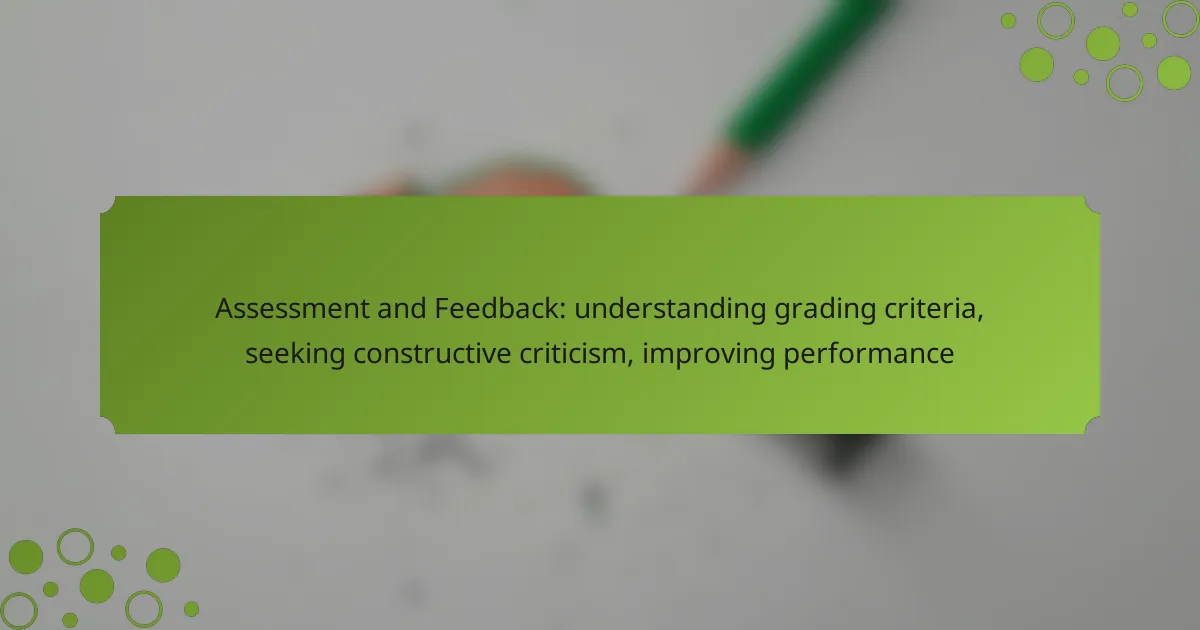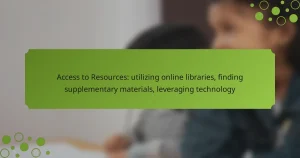
Understanding grading criteria is essential for students aiming to enhance their performance in online courses. By familiarizing themselves with the structured frameworks used for assessments, learners can identify key areas to focus on and seek constructive criticism effectively. This proactive approach not only clarifies their goals but also fosters meaningful feedback that drives improvement.

How can grading criteria improve performance in online courses?
Grading criteria provide a structured framework that helps students understand expectations and enhance their performance in online courses. By clearly outlining how assessments are evaluated, students can focus their efforts on key areas that contribute to their success.
Clear expectations enhance understanding
When grading criteria are clearly defined, students gain a better understanding of what is required to succeed. This clarity reduces ambiguity and allows learners to align their study habits with the expectations set by instructors.
For example, if a course specifies that 30% of the grade comes from participation, students can prioritize engaging in discussions and activities that contribute to this aspect. Clear expectations help students manage their time and efforts more effectively.
Specific metrics guide student efforts
Specific metrics within grading criteria provide tangible goals for students to aim for, which can significantly enhance their performance. Metrics such as rubrics detail how different components of an assignment are weighted, allowing students to focus on areas that will maximize their scores.
For instance, a rubric that allocates points for clarity, organization, and research depth can guide students in structuring their work. By understanding how each element contributes to their overall grade, students can allocate their time and resources more strategically.
Alignment with learning objectives
Grading criteria that align with learning objectives ensure that assessments measure what students are actually expected to learn. This alignment helps students see the relevance of their assignments and motivates them to engage more deeply with the material.
For example, if a learning objective is to develop critical thinking skills, grading criteria that emphasize analysis and evaluation in assignments will encourage students to practice these skills. This connection fosters a more meaningful learning experience and improves overall performance.

What are common grading criteria in online courses?
Common grading criteria in online courses typically include rubrics for assignments, participation and engagement metrics, and peer review standards. These criteria help instructors assess student performance and provide clear expectations for learners.
Rubrics for assignments
Rubrics are structured scoring guides that outline specific criteria for evaluating assignments. They usually include categories such as content quality, organization, grammar, and adherence to guidelines. For example, a rubric might assign points based on how well a student addresses the assignment prompt and the clarity of their arguments.
When using rubrics, it’s essential to ensure they are clear and detailed. This helps students understand how to meet expectations and where they can improve. A well-designed rubric can also streamline the grading process, making it more efficient for instructors.
Participation and engagement metrics
Participation and engagement metrics assess how actively students contribute to discussions and activities in the course. This can include attendance in live sessions, contributions to forums, and completion of interactive assignments. For instance, a course might allocate a percentage of the final grade to participation based on these factors.
To improve engagement, students should actively participate in discussions and seek clarification when needed. Instructors can enhance participation by creating a welcoming environment and encouraging questions and feedback. Tracking engagement can help identify students who may need additional support.
Peer review standards
Peer review standards involve evaluating the work of fellow students based on established criteria. This process encourages collaboration and critical thinking, allowing students to learn from each other’s strengths and weaknesses. Typically, peer reviews focus on aspects like clarity, argument strength, and adherence to assignment guidelines.
For effective peer reviews, students should be provided with clear guidelines on how to give constructive feedback. Instructors can facilitate this by offering training on providing useful critiques and establishing a respectful review culture. This not only enhances learning but also builds a sense of community among students.

How to seek constructive criticism effectively?
To seek constructive criticism effectively, focus on being specific about the feedback you need and the areas you want to improve. This approach not only clarifies your goals but also encourages more meaningful and actionable responses.
Ask targeted questions
When seeking feedback, formulate specific questions that guide the reviewer to provide relevant insights. For example, instead of asking, “What do you think?”, try asking, “How can I improve the clarity of my argument?” This specificity helps the reviewer focus on particular aspects of your work.
Consider using open-ended questions that prompt deeper analysis, such as “What areas do you feel need more evidence?” This encourages a dialogue that can uncover valuable perspectives.
Utilize feedback forms
Feedback forms can streamline the process of gathering constructive criticism. Create a structured form that includes specific criteria related to your work, such as clarity, organization, and engagement. This allows reviewers to provide focused feedback based on predefined standards.
Ensure the form is user-friendly and concise, encouraging quick responses. You might include rating scales or open-ended sections for additional comments, which can help you identify trends in the feedback you receive.
Engage in one-on-one discussions
One-on-one discussions provide an opportunity for in-depth feedback and clarification. Schedule a meeting with a mentor or peer where you can present your work and ask for their insights. This format allows for immediate follow-up questions and a more nuanced understanding of their feedback.
During these discussions, be open to criticism and ask clarifying questions to ensure you fully grasp the feedback. This interaction can foster a supportive environment where constructive criticism is more readily shared and understood.

What strategies can improve feedback reception?
Improving feedback reception involves adopting specific strategies that enhance your ability to understand and utilize constructive criticism. Key approaches include maintaining an open mindset, focusing on actionable insights, and practicing active listening.
Maintain an open mindset
Having an open mindset means being receptive to feedback without defensiveness. This attitude allows you to view criticism as an opportunity for growth rather than a personal attack. Embrace the idea that feedback is a valuable tool for improvement.
To cultivate this mindset, remind yourself that everyone has areas for development, and constructive criticism is a normal part of learning. Regularly reflect on past feedback and how it has contributed to your progress to reinforce this perspective.
Focus on actionable insights
When receiving feedback, concentrate on identifying specific, actionable insights that can guide your improvement. Look for clear suggestions or examples that can be implemented in your work or study habits. This approach helps transform vague criticism into practical steps.
For instance, if feedback indicates that your writing lacks clarity, ask for specific examples of unclear sections. This will enable you to understand exactly what needs to change and how to make those adjustments effectively.
Practice active listening
Active listening is crucial for effectively receiving feedback. This means fully concentrating on the speaker, understanding their message, and responding thoughtfully. Avoid interrupting and instead, ask clarifying questions to ensure you grasp the feedback being given.
To practice active listening, maintain eye contact, nod to show understanding, and summarize what you’ve heard to confirm comprehension. This not only demonstrates respect but also enhances your ability to absorb and act on the feedback provided.

How can students apply feedback to enhance learning?
Students can enhance their learning by actively applying feedback received from assessments. This involves understanding the feedback, setting goals for improvement, and making necessary changes in future assignments.
Set specific improvement goals
Establishing specific improvement goals helps students focus on areas that need development. For example, if feedback indicates a lack of clarity in writing, a student might set a goal to practice writing concise paragraphs.
Goals should be measurable and time-bound, such as aiming to improve writing clarity by submitting a revised draft within two weeks. This structured approach keeps students accountable and motivated.
Reflect on feedback regularly
Regular reflection on feedback is crucial for continuous improvement. Students should take time after receiving feedback to analyze what was said and how it applies to their work.
Creating a feedback journal can be beneficial. In this journal, students can summarize feedback, note their thoughts, and track their progress over time, ensuring they are actively engaging with the information provided.
Incorporate changes in future assignments
Applying changes based on feedback in future assignments is essential for growth. Students should review the feedback and identify specific strategies to implement in their next tasks.
For instance, if feedback suggests using more evidence in arguments, students can focus on integrating relevant research or examples in upcoming essays. This practice not only improves their work but also reinforces learning from past experiences.

What role does peer feedback play in online courses?
Peer feedback is essential in online courses as it fosters a supportive learning environment and enhances the educational experience. It allows students to receive constructive criticism from their peers, which can lead to improved understanding and performance.
Encourages collaboration and community
Peer feedback promotes collaboration among students, creating a sense of community within the online learning space. When students engage in giving and receiving feedback, they build relationships and develop a network of support that can enhance their learning journey.
To maximize collaboration, students should actively participate in discussions and provide thoughtful feedback. Setting up peer review groups can facilitate this process, allowing for regular interaction and shared learning experiences.
Provides diverse perspectives
Receiving feedback from peers exposes students to a variety of viewpoints, which can enrich their understanding of the subject matter. Different perspectives can highlight aspects of their work that they may not have considered, leading to deeper insights and improved outcomes.
Students should be encouraged to seek feedback from peers with different backgrounds or areas of expertise. This diversity can lead to more comprehensive evaluations and innovative ideas that enhance overall learning.
Enhances critical thinking skills
Engaging with peer feedback helps students develop critical thinking skills by requiring them to analyze and evaluate the work of others. This process encourages them to reflect on their own work and consider how it aligns with established criteria and standards.
To enhance critical thinking, students should be taught how to give constructive feedback that is specific and actionable. They can use frameworks or rubrics to guide their evaluations, ensuring that their feedback is focused and relevant.


